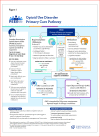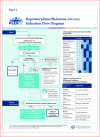Managing opioid use disorder in primary care: PEER simplified guideline
- PMID: 31088869
- PMCID: PMC6516701
Managing opioid use disorder in primary care: PEER simplified guideline
Erratum in
-
Correction.Can Fam Physician. 2019 Oct;65(10):687. Can Fam Physician. 2019. PMID: 31604731 Free PMC article. No abstract available.
-
Correction.Can Fam Physician. 2019 Oct;65(10):687. Can Fam Physician. 2019. PMID: 31604732 Free PMC article. English. No abstract available.
Abstract
Objective: To use the best available evidence and principles of shared, informed decision making to develop a clinical practice guideline for a simplified approach to managing opioid use disorder (OUD) in primary care.
Methods: Eleven health care and allied health professionals representing various practice settings, professions, and locations created a list of key questions relevant to the management of OUD in primary care. These questions related to the treatment setting, diagnosis, treatment, and management of comorbidities in OUD. The questions were researched by a team with expertise in evidence evaluation using a series of systematic reviews of randomized controlled trials. The Guideline Committee used the systematic reviews to create recommendations.
Recommendations: Recommendations outline the role of primary care in treating patients with OUD, as well as pharmacologic and psychotherapy treatments and various prescribing practices (eg, urine drug testing and contracts). Specific recommendations could not be made for management of comorbidities in patients with OUD owing to limited evidence.
Conclusion: The recommendations will help simplify the complex management of patients with OUD in primary care. They will aid clinicians and patients in making informed decisions regarding their care.
Copyright© the College of Family Physicians of Canada.
References
-
- Special Advisory Committee on the Epidemic of Opioid Overdoses. National report: apparent opioid-related deaths in Canada (January 2016 to March 2018). Ottawa, ON: Public Health Agency of Canada; 2018.
-
- Gomes T, Khuu W, Craiovan D, Martins D, Hunt J, Lee K, et al. Comparing the contribution of prescribed opioids to opioid-related hospitalizations across Canada: a multi-jurisdictional cross-sectional study. Drug Alcohol Depend. 2018;191:86–90. Epub 2018 Jul 31. - PubMed
-
- Canadian Institute for Health Information. Pan-Canadian trends in the prescription of opioids, 2012 to 2016. Ottawa, ON: Canadian Institute for Health Information; 2017. Available from: https://secure.cihi.ca/free_products/pan-canadian-trends-opioid-prescrib.... Accessed 2019 Mar 10.
Publication types
MeSH terms
LinkOut - more resources
Full Text Sources
Medical


